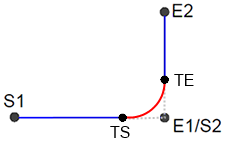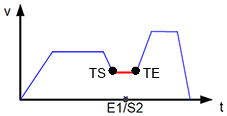Transition Between Moves
A transition mode must be specified when a new move is appended to a move that is already in progress.
- Different transition parameters may be required, depending on the transition mode.
- This characterizes the contour of the transition segment.
The supported transition modes are:
Transition Mode Parameters
|
Parameters |
Number of Transition |
Transition Parameter Index |
Transition Parameter Name |
Transition Parameter Description |
Units |
|---|---|---|---|---|---|
|
TM_NONE |
0 |
N/A |
N/A |
No transition. |
N/A |
|
TM_CORNER_DISTANCE |
2 |
0 |
Corner Distance |
Distance to the corner of the deviation and the return point from the original contour. |
User units |
|
TM_CORNER_DISTANCE |
2 |
1 |
Velocity |
The velocity value of the transition segment. |
User unit/sec |
|
TM_SCURVE_CORNER |
1 |
0 |
Corner Distance |
Distance to the corner of the deviation and the return point from the original contour. |
User units |
No Transition (TM_NONE)
Insert no transition contour segment.
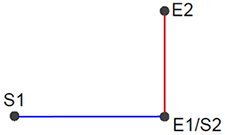
|
|
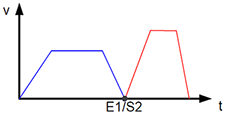
|
|
Motion Path |
|
Motion Velocity Profile |
- The motion blocks are not modified and no transition curve is inserted using this mode.
- This is the only possible transition mode for the Buffer Modes.
- No transition parameters are used for this transition mode.
Corner Distance (TM_CORNER_DISTANCE)
Transition with given corner distance.
|
|
|
|
|
Motion Path |
|
Motion Velocity Profile |
The corner distance transition mode is specified using TM_CORNER_DISTANCE as the transition mode for a motion block.
Transition Parameter Index
|
Transition Parameter Index |
Name |
Description |
|---|---|---|
|
0 |
Corner Distance |
Distance to the corner of the deviation and the return point from the original contour. |
|
1 |
Velocity |
The velocity value of the transition segment. |
- Corner Distance transitions are handled differently, depending upon whether the connecting moves are lines or arcs, and all of the possible combinations, (line-line, arc-arc, line-arc, arc-line).
- Arc-to-Arc transitions shorten the arc with the larger radius by the corner distance.
- Line-to-Arc and Arc-to-Line transitions shorten the linear move.
- Line-to-Line transitions shorten the next move by the corner distance.
S-Curve Corner (TM_SCURVE_CORNER)
Transition with given corner distance, using Jerk for each axis profile.
|
|
|
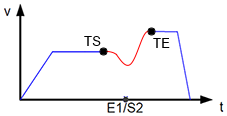
|
|
Motion Path |
|
Motion Velocity Profile |
The S-Curve Corner transition mode is specified using TM_SCURVE_CORNER as the transition mode for a motion block.
Transition Parameter Index
|
Transition Parameter Index |
Name |
Description |
|---|---|---|
|
0 |
Corner Distance |
Distance to the corner of the deviation and the return point from the original contour. |
- All S-Curve Corner transitions start and end the transition with zero acceleration.
- If an S-Curve Corner transition is used with buffer mode BM_ABORTING and during acceleration or deceleration phases of the first move, then the axes experience an acceleration discontinuity at beginning of the transition.
- Only Line-to-Line transitions are supported with S-Curve Corner.
- Line-arc, arc-arc, arc-line are not supported.
- Line-to-Line transitions shorten the next move by the corner distance.
- Changes to the velocity override during the transition do not take effect until after the transition has completed.
- S-Curve Corner transitions only depend on the corner distance, the incoming and outgoing move velocities, and the incoming and outgoing move directions.
- The transition may exceed the maximum specified values for velocity, acceleration, deceleration, and jerk of the incoming and outgoing moves.
- Jerk and peak acceleration increase with a larger angle between the incoming and outgoing move directions.
- Jerk and peak acceleration decrease with a larger corner distance.
- The transition may exceed the maximum specified values for velocity, acceleration, deceleration, and jerk of the incoming and outgoing moves.
- To approximate the path peak acceleration and jerk during the transition, we can use these equations:
- Vavg = The average of the slew speeds of the incoming and outgoing moves.
- θ = The angle between incoming and outgoing moves.
- CD = Corner distance.


- If actual accel = ka typical accel and actual jerk = kj typical jerk, then:
- ka has an average value of 1 with a standard deviation of 0.5.
Values of ka have been observed as large as 3. - kj has an average value of 1 with a standard deviation of 1.1.
Values of kj have been observed as large as 12.
- ka has an average value of 1 with a standard deviation of 0.5.
-
- The formulas are approximate guidelines.
Your application may experience different behavior.
See Also
